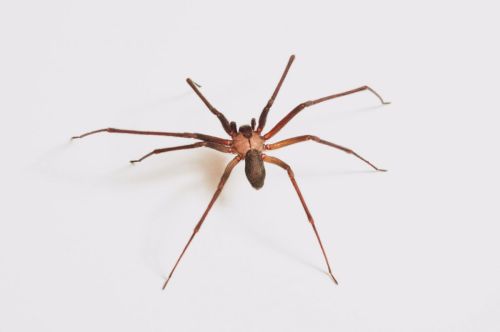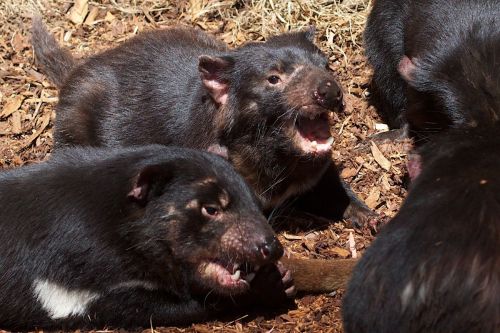The first ancestors of today's specimens appeared on Earth about 400 million years ago. They evolved from marine organisms of the chelicera subphylum. The oldest ancestor of today's spiders found in fossil records is Attercopus fimbriunguis, which dates back 380 million years.
These are invertebrates whose body is divided into segments and have an external skeleton. Spiders are classified as arachnids, which include approximately 112.000 species of animals.
The division is not yet finally systematized, because since 1900, over 20 different classifications of these animals have appeared.
These are the cephalothorax and the abdomen, which are connected by a style. In front of the cephalothorax, there are chelicerae and behind them there are pedipalps. These are followed by the walking legs. The abdomen contains organs such as the heart, intestines, reproductive system, cotton glands, and spiracles.
The smallest species is Patu digua from Colombia, whose body length does not exceed 0.37 mm. The largest spiders are tarantulas, which can grow up to 90 mm in length and their leg span can be up to 25 cm.
It is a pair of pedipalps and four pairs of walking legs.
They are used to spinning silk thread from which spiders build their webs. Most often, spiders have six silk glands, but there are species with only one, two, four, or eight. Silk nets can be used not only to build webs but also to transfer sperm, build cocoons for eggs, wrap prey, and even build balloons/parachutes so they can fly.
The tarsus ends with claws, the number and length of which vary depending on the spider species. Web-weaving spiders usually have three claws, while actively hunting spiders usually have two.
They end with fangs, which the spider uses to tear open the body of its prey and also to defend itself. In many species, they end with the mouth of venom glands.
They lack the metatarsus segment. In males, the last segment (tarsus) is used for reproduction, while the first (coxa) in both sexes is modified to make it easier for the spider to eat.
However, this is not a rule, as there are families of spiders with six (Haplogynae), four (Tetrablemma), or two (Caponiidae). There are also species of spiders that do not have eyes at all. Some pairs of eyes are more developed than others and serve different purposes, for example, the primary eyes of jumping spiders are capable of color vision.
The bristles covering them have the ability to detect sounds, smells, vibrations, and air movements.
This is especially popular among web-weaving spiders. Some species can also locate prey by detecting changes in air pressure.
Their central eyes are enlarged and point directly forward. Equipped with excellent lenses, they cover a very large field of view and collect more light than the eyes of owls or cats. This ability is due to the lack of a reflective membrane. The eye is not well protected and is seriously damaged every morning, but its regenerative properties are so outstanding that it regenerates quickly.
These spiders also do not have ears and they use the hairs on their legs to "listen" for prey. They can thus detect sounds within a two-meter radius.

This means that they do not have veins, but hemolymph (which performs the function of blood) is pumped through arteries into the body cavities (hemocele) surrounding the internal organs. There, gas and nutrients are exchanged between the hemolymph and the organ.
Lung tracheas evolved from the legs of aquatic arachnids. Tracheae, in turn, are bulges in the body walls of spiders. They are filled with hemolymph, which is used to transport oxygen and has an immune function.
Most of them feed only on meat, although there are species (Bagheera Kipling) whose diet consists of 90% plant ingredients. The young of some spider species feed on plant nectar. There are also scavenger spiders, which feed mainly on dead arthropods.
Although there are so many of them, only some species pose a threat to humans. There are also spiders that do not have venom glands at all, such as spiders from the Uloboridae family.
Such a toxin would be able to protect crops from harmful insects without polluting the natural environment.
First, digestive juices are injected into the victim's body, which dissolves the victim's tissues, and the next stage of digestion takes place after the spider absorbs these tissues inside the digestive system.
Thanks to this, they can weave a new, fresh one without having to hunt when the old web is no longer suitable for this purpose. A beautiful example of recycling among animals. A similar mechanism occurs in shrimps, which eat their shell during molting.
Most have a mouthpart equipped with a straw-like device that allows them to drink the dissolved tissues of their prey.
They capture harmful metabolites from the hemolymph and direct them to the cloaca, from where they escape through the anus.
Only after these containers are filled with sperm does the male set out to look for a partner. During copulation, they are introduced into the female's external genitalia called epigynum, where fertilization occurs. This process was observed already in 1678 by Martin Lister, an English physician and naturalist.
They are often stored in silk cocoons that maintain appropriate humidity. Spider larvae undergo metamorphosis while still in the cocoons and leave them when they reach a mature body shape.
This feature is the domain of jumping spiders, which have very good eyesight. If the dance convinces the female, fertilization occurs, otherwise the male must look for another partner, less demanding of sophisticated cat movements.
Most often, it is the male who falls victim to the female - usually during or after copulation. Cases where a male eats a female are extremely rare. There are species where in up to ⅔ of cases the male is eaten by the female. In turn, the roles are reversed among water spiders (Argyronetia aquatica), where males often eat smaller females and copulate with larger females. In Allocosa brasiliensis spiders, males eat older females whose reproductive abilities are no longer as good as those of younger ones.
These, in turn, eliminate the weakest siblings, thus gaining an advantage over others and giving themselves a greater chance of reaching adulthood.
A spider that eats more food will grow larger as an adult. Therefore, we can hypothesize that the larger the spider we encounter (concerning representatives of its species), the more aggressive it is.












